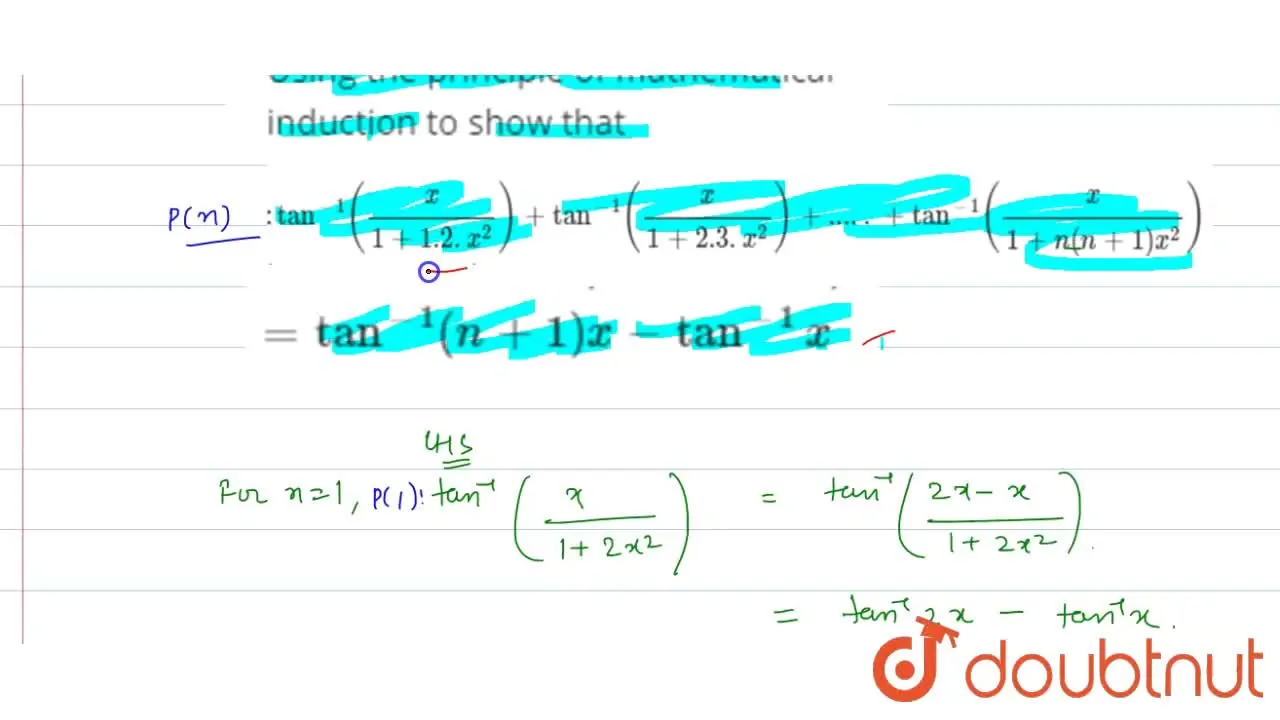Using the principle of mathematical induction to show that tan−1(n+1)x−tan−1x,∀x∈N.
Let P(n):tan−1(x1+1.2.x2)+tan−1(x1+2.3.x2)+.....+tan−1(x1+n(n+1)x2) .....(i)
=tan−1(n+1)x−tan−1x
Step I For n=1.
LHS of Eq. (i) =tan−1(x1+1.2.x2)
=tan−1(2x−x1+2x.x)=tan−12x−tan−1x
=RHS of Eq.(i)
Therefore , P(1) is true.
Step II Assume it is true for n=k.
P(k):tan−1(x1+1.2x2)+tan−1(x1+2.3x2)+......+tan−1(x[1+k(k+1)x2])
=tan−1(k+1)x−tan−1x
Step III For n=k+1.
P(k+1):tan−1(x1+1.2.x2)+tan−1(x1+2.3.x2)+.....+tan−1(x1+k(k+1)x2)+......+tan−1(x1+(k=1)(k+2)x2)
=tan−1(k+2)x−tan−1x
∴LHS=tan−1(x1+1.2.x2)
+tan−1(x1+2.3.x2)+....+tan−1(x1+k(k+1)x2)+tan−1(x1+(k+1)(k+2)x2)
tan−1(k+1)x−tan−1x+tan−1(x1+(k+1)(k+2)x2)
=tan−1(k+1)x−tan−1x+tan−1((k+2)x−(k+1)x1+(k+2)x(k+1)x)
=tan−1(k+1)x−tan−1x+tan−1(k+2)x−tan−1(k+1)x=tan−1(k+2)x−tan−1x=RHS
This shows that the result is true for n=k+1. Hence , by the principle of mathematical induction , the result is true for all the n∈N.
Related Playlists
- BOOK - ARIHANT MATHSCHAPTER - MATHEMATICAL INDUCTION EXERCISE - Mathematical Induction Exercise 1: (Single Option Correct Tpye Questions)3videos
MATHEMATICAL INDUCTION
- BOOK - ARIHANT MATHSCHAPTER - MATHEMATICAL INDUCTION EXERCISE - Exercise (Statement I And Ii Type Questions)3videos
MATHEMATICAL INDUCTION
- BOOK - ARIHANT MATHSCHAPTER - LOGARITHM AND THEIR PROPERTIESEXERCISE - Exercise (Questions Asked In Previous 13 Years Exam)4videos
LOGARITHM AND THEIR PROPERTIES
- BOOK - ARIHANT MATHSCHAPTER - MATRICES EXERCISE - Exercise (Questions Asked In Previous 13 Years Exam)49videos
MATRICES
Similar Questions
Using the principle of mathematical induction ,prove that (1+x)n≥(1+nx) for all n∈N, where x>-1.
View SolutionUsing the principle of mathematical induction, prove that (23n−1) is divisible by 7 for all n∈N
View SolutionUse the principle of mathematical induction to show that 52n+1+3n+2.2n−1 divisible by 19 for all natural numbers n.
View SolutionUse the principle of mathematical induction to show that an−b9n) is divisble by a−b for all natural numbers n.
View SolutionIf A=⎡⎢⎣111011001⎤⎥⎦ , then use the principle of mathematical induction to show that An=⎡⎢ ⎢⎣1nn(n+1)201n001⎤⎥ ⎥⎦ for every positive integer n .
View SolutionUsing the Principle of mathematical induction, show that 11n+2+122n−1, where n is a naturla number is a natural number is divisible by 133.
View SolutionUsing the principle of mathematical induction. Prove that (xn−yn) is divisible by (x−y) for all n∈N.
View SolutionProve by the principle of mathematical induction that n(n+1)(2n+1) is divisible by 6 for all n∈N
View SolutionProve the following by the principle of mathematical induction: x2n−1+y2n−1 is divisible by x+y for all n∈N.
View SolutionUsing principle of mathematical induction prove that x2n−y2n is divisible by x+y for all n∈N.
View Solution


